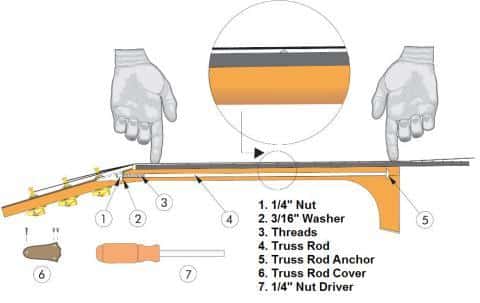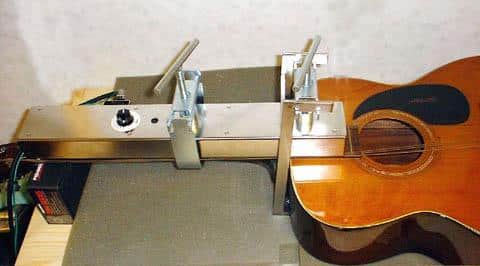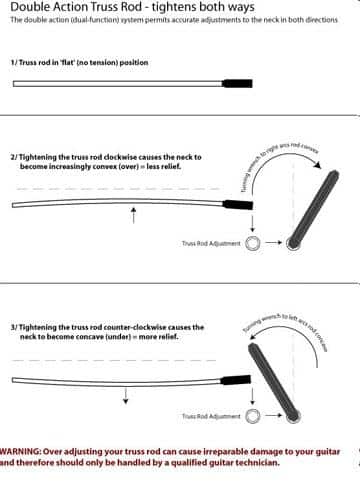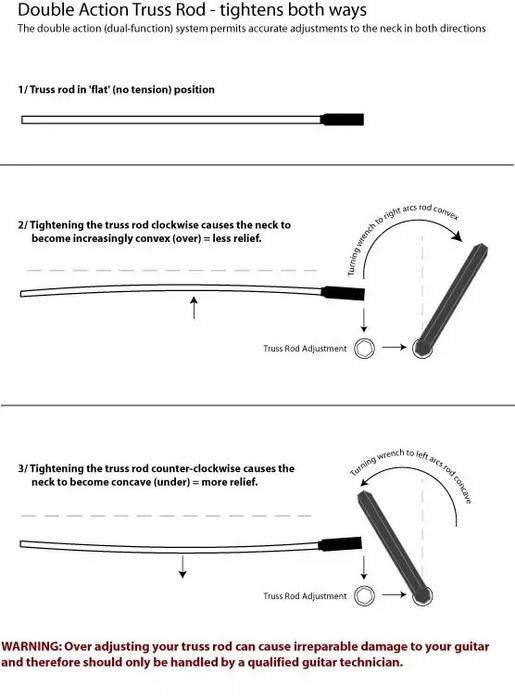Straight from the world of guitar craftmanship, where precision, passion, and knowledge are intertwined, I invite you on a unique exploration journey in my lutherie years. Picture this: a high-stakes performance, a prized guitar, the horrified realization of the neck’s back bow just hours before the show. As a seasoned luthier, it was a defining moment – a thrilling undertaking with the clock ticking. Now, how did that go?
Over years of tinkering with the complexities of guitar anatomy, particularly the nuanced art of correcting a back bow in a guitar neck, I’ve acquired an assortment of practical insights. This comprehensive guide eloquently encapsulates that wisdom, designed specifically for the novice and skilled players, spotlighting the causes, effects, and in-depth repair techniques. By leveraging this resource, the mystery of back bow will transform into an attainable skill, strengthening your musical journey. After all, mastering this often-overlooked aspect of guitar maintenance can make you the hero of your own pre-show crisis.
Understanding Back Bow in Guitar Neck
Causes of Back Bow

As a seasoned luthier, I can confidently state that a keen understanding of what causes back bow is a significant starting point to remedy it. Primarily, two key factors contribute to back bow in a guitar neck: string tension and humidity. String tension plays a crucial role because overly tight strings exert excessive pressure on the neck, causing it to bend backwards. Over time, such strain leads to a pronounced back bow that hampers your instrument’s playability.
Moreover, various external environmental influences, primarily humidity, significantly impact your guitar neck. With too little moisture, the wood contracts and often results in an undesirable neck bow. Conversely, excessive humidity can cause the neck to swell and warp. Therefore, achieving a controlled balance of these factors is critical to maintaining a healthy guitar neck. My years of experience have taught me the value these elements hold, providing a stepping stone for us as we delve further into the effects of back bow and how it can be rectified.
Effects of Back Bow

In my long-standing experience as a guitar technician, it’s evident that the effects of back bow in a guitar neck are commonly overlooked. Understanding Back Bow in Guitar Neck is not just about identifying the root cause. It’s equally crucial to appreciate its implications on your instrument’s performance. A warped neck, typically resulting from back bow, can manifest in disruptive ways, with fretting out being one of the most common symptoms. Your guitar’s tone might suffer dramatically, notes may buzz, or cease entirely on certain frets – it’s a frustration I’ve counselled many musicians through. By acknowledging these impacts, you’re well placed to take necessary corrective action, enhancing the longevity and performance of your beloved instrument. Stay tuned as the subsequent sections guide you through the correction and prevention of back bow, empowering you with the knowledge to maintain a guitar neck in optimal shape.
Repairing and Correcting Back Bow
Using the Truss Rod

Moving to the core part of our guide, dealing with repairing and correcting back bow, I often find myself relying on the truss rod. You might be wondering, why so? This part of the guitar is intricately designed to provide the perfect balance for the neck, and hence plays a pivotal role in remedying back bow issues. The primary function of the truss rod is to counteract the tension of the strings, enabling precise neck adjustment.
Adjusting the truss rod involves a simple turn, either tightening or loosening, depending on the level of the neck’s concavity or convexity. A cautious tweak can effectively straighten out the unwanted curve, providing a quick yet lasting solution. Please note, any truss rod adjustment must be done delicately so as not to damage the neck. Furthermore, patience is key, as the effects of such adjustments are often observed over time, rather than instantly. Through my experience, I find the truss rod adjustment to be an indispensable technique in maintaining the health of guitar necks.
Application of Heat

In my journey to correct back bow in guitar necks, application of heat is a critical stage. Using heat lamps, I’ve been able to reverse many instances of back bow effectively. What heat does is soften the wood, allowing for malleability, which aids in straightening out that back bow.
But proceed with caution: too much heat can damage the finish, and even the wood itself. It’s a delicate balance, a dance between heat and timing, that I’ve learned to master. The heat lamp should be kept at a safe distance, not too close to the guitar neck, as this reduces the risk of potential damage.
Proper execution of this step, in sync with truss rod adjustment, can correct a back bow situation in a way that retains the guitar’s playability and aesthetics. This is an essential part of our discussion on ‘Repairing and Correcting Back Bow’.
Maintaining a Healthy Guitar Neck
Controlled Humidity and String Tension

As part of maintaining a healthy guitar neck, proper humidity and string tension are crucial. In my experience, an environment with controlled humidity is key to preventing significant issues like back bow. I use humidification devices during dry seasons, a practice that has greatly contributed to the longevity of my instruments.
Altering string tension also helps combat back bow. By lowering the tension, you lighten the load, which can help straighten the neck. Conversely, maintaining a higher string tension can be used if the neck is too straight or has a forward bow. From my perspective, there’s a sweet spot in finding the right balance between humidity control and string tension that is highly instrumental in maintaining the overall health of a guitar neck.
In sum, a proactive and informed approach to controlling humidity and managing string tension is vital to the optimal maintenance of your guitar neck.
Periodic Checkups and Adjustments

As a seasoned luthier, I’ve learnt that just like our health, a guitar’s wellness also hinges on periodic checkups and adjustments. It’s akin to proactive guitar maintenance. Regular inspection of the guitar neck allows you to detect early signs of back bow, helping to prevent its detrimental effects. It’s not just about visually inspecting the neck. It’s about feeling the strings, observing their response and understanding the nuanced changes over time.
Furthermore, reliable adjustments like timely truss rod tweaks can significantly help in maintaining an optimal neck curvature. Even the string tension and humidity levels might need periodic adjustments, as they directly influence the neck health. Remember, prevention is always better and cheaper than cure. By incorporating these small yet crucial measures into your routine, you can effectively counteract back bow and maintain a healthy guitar neck.
In the upcoming sections, I’ll answer some frequently asked questions on back bow, string tension, and more.
FAQs
What is a back bow in a guitar neck?
How can I identify a back bow in my guitar neck?
How can I correct a back bow in my guitar neck?
When should I consider professional help for correcting a back bow in my guitar neck?
Conclusion
Battle the back bow bravely! This mantra has steered me through over two decades of my engagement with guitars, and I hope it also empowers you to restore a healthy neck in your instrument. Your guitar sounds better when its neck is stress-free, so it’s crucial for you to understand the causes and effects of back bow.
By pairing this understanding with the best practices for repair and correction shared in this guide, such as the effective use of the truss rod and the application of heat, you’ll be fully equipped to combat back bow effectively. Maintaining controlled humidity and string tension and conducting periodic checkups also play pivotal roles in preserving a healthy guitar neck.
In conclusion, just remember – the battle against back bow is not won in a day. Gradually, with patience and consistency, you’ll be able to not only correct the issue but also prevent it from occurring in future. So let’s pick up our guitars, and face the music head on.